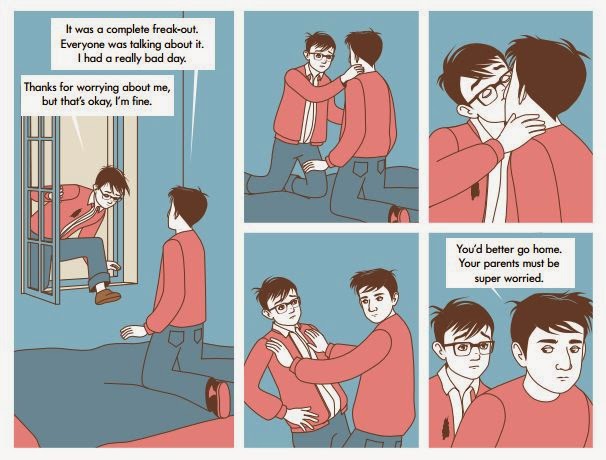- GUTTERFAGS -
Quarterly reviews of sequential art about
dude-on-dude lust and love
-- Back to the front page for more reviews!
Gutterfags is sponsored by Sticky Graphic Novels, an imprint of gay character-based, sex-positive graphic novels published in hardcover by Bruno Gmünder GmbH and in digital format by Class Comics.


Adrian and the Tree of Secrets
by Hubert and Marie Caillou, translated by David Homel
reviewed by Mike Martinez for Gutterfags
Adrian has a problem. He’s young, he has an oppressive mother, an oppressive school, and he likes people even less than they like him. Nothing in Adrian’s life seems to go his way until, another boy, far more popular, goes from literally causing him pain to kissing him.
The story is told in a flat color style that, while monochromatic, is totally suited to the style of drawing presented here. The color fairly glows even though composition is pretty simple. Shades of color are expressive and the story is cleanly sequential and well told with as few words as possible.
The panel work is evocative of an earlier era in illustration. But the story told is pretty straight forward; it relies on tropes and clichés that may still be true in rural France or small town America but the modern urban reader may have issues with it. The progression from isolation, to abuse, to hope, and finally to despair is a well-trodden path in gay narrative and the comic doesn’t bring anything new to it. The only new wrinkle to the story is that the reader is falsely given hope in the form of Adrian’s aunt who has found a way to ignore small minds in small towns and make a life or her own while still challenging her sister (Adrian’s mother) to open her eyes to Adrian’s despair.
His aunt also has no effect on Adrian’s school environment, either. Adrian’s fellow students at his Catholic high school see him as odd. They alternately ignore and abuse him daily. His teachers see the abuse and allow it to continue because Adrian is different. Several of his teachers seem to actively encourage the abuse Adrian is forced to deal with. But the abuse leads Adrian to find a friend; when Jeremy, Adrian’s chief tormentor, actually draws blood in a Phys. Ed. class, the resulting confrontation actually brings the two boys closer together. They discover shared likes and the need to find quiet places where they can be their true selves. When Adrian’s new friend kisses him, the world seems to be changed. Adrian has a new friend, a lifeline to perhaps a better life, and Jeremy finally has someone he can be himself with instead of playing the cool kid at school that all of his friends expect him to be.
Adrian is taken to Jeremy’s secret place in his favorite tree where experimentation begins between the two. First cigarettes, first kisses, comparing how they both realized they prefer boys to girls. The problem is Jeremy already has a girl; she follows the two fast friends and, in a fit of anger, exposes the boy’s budding love. After an incident of gay bashing for which the Catholic school and its headmaster priest blame the victim, Adrian is once again shunned and cast adrift in a sea of prejudice and hate. He loses Jeremy and loses faith in himself. In the end, he commits a self-destructive act that, while in keeping with the story, is the ultimate cliché and betrayal of the reader.
The book was originally published in 2013, and the translation published in 2015. The tropes used throughout the book have been long used and should be put to bed once and for all. The end leaves the reader without hope. The overpowering sadness really makes this more soap opera than a complete story. One assumes the idea was to give a bittersweet view of young love in an oppressive environment. Instead, it leaves the reader with a very bleak outlook of life -- one that our modern age has shown us is less and less likely the necessary outcome of the book.
Overall, the cartooning in Adrian and the Tree of Secrets, its color and line work, is among the best in this style. But the story is average at best. I can recommend the book on style and color alone but the reader needs to be aware that if you’re looking for an uplifting read, this may not be the book for you.
- About the reviewer -
Mike Martinez lives in Chicago and works in beta reading, reviewing, and critiquing fiction primarily in the M/M genre. He writes short fiction that makes the City of Chicago as much a character of his works as the people who populate them. He also works in event production for major events and does random child care for a small number of children who benefit from his love of iambic pentameter and all genres of music other than rap.